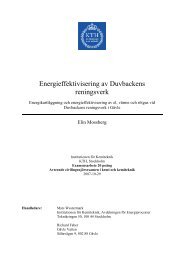Problematik vid höga flöden - Gästrike Vatten AB
Problematik vid höga flöden - Gästrike Vatten AB
Problematik vid höga flöden - Gästrike Vatten AB
Create successful ePaper yourself
Turn your PDF publications into a flip-book with our unique Google optimized e-Paper software.
primary sludge hydrolysis. For the same reasons the maximum influx-flow was also lowered<br />
from 3000 m 3 /h to 2500 m 3 /h to both the primary sludge hydrolysis and the biological stage.<br />
During both december 2007 and 2008, the WWTP experienced exceptional high-flow<br />
conditions with a slightly higher mean influx flow during 2008 compared to 2007. In figure 7<br />
the effluent phosphorus load and the usage of precipitation chemicals for the two periods are<br />
plotted, as well as three months afterwards, when the operation conditions had returned to<br />
normal. At december 2008, the bypass point had been changed, and this year less than half the<br />
amount of phosphorus was discharged and less than one third of precipitation chemicals were<br />
used compared to the year before. After the high-flow event 2007 the EBPR process was<br />
deteriorated for about three months. 2008 the process recovered much faster, which led to a<br />
lower effluent phosphorus load with only one fifth of precipitation chemicals.<br />
P (kg)<br />
1600<br />
1200<br />
800<br />
400<br />
0<br />
(a) Effluent phosphorus load<br />
December January-March<br />
Bypass at 3000 m3/h, 2007 Bypass at 2500 m3/h, 2008<br />
Figure 7. (a) Effluent phosphorus load and (b) usage of precipitation chemicals before and after optimization<br />
changes in the process. During (December) and after (January to March) high-flow conditions in 2007 and 2008.<br />
The overall results from the changes implemented were: a more stable process, smaller<br />
effluent peaks, a minimal usage of precipitation chemicals, avoiding need for external carbon<br />
source and less energy consumption. In figure 8, a plot of the usage of precipitation chemicals<br />
and the effluent phosphorus load during the years 2006 to 2009 is presented. In 2009 the<br />
effluent phosphorus load and the usage of precipitation chemicals were the lowest since the<br />
WWTP was rebuilt for EBPR, and this makes the prospects for managing the stringed<br />
demands 2012 optimistic.<br />
Effluent P (tonne)<br />
8<br />
6<br />
4<br />
2<br />
0<br />
Figure 8. Overall effluent phosphorus load and total usage of precipitation chemicals from the year 2006 to 2009.<br />
61<br />
FeCl 3 (tonne)<br />
60<br />
40<br />
20<br />
0<br />
(b) Chemical precipitation<br />
December January-March<br />
chemical<br />
300<br />
200<br />
Precipitation<br />
100<br />
0<br />
2006 2007 2008 2009<br />
Year<br />
Effluent P Precipitation chemical<br />
(tonne)






